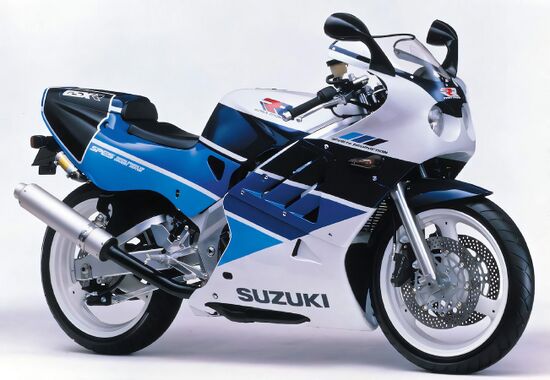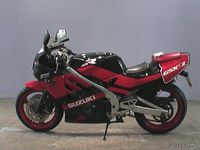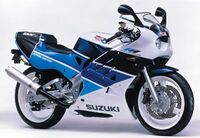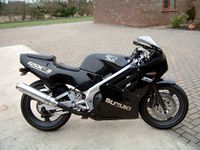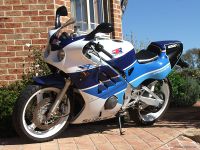Difference between revisions of "Suzuki GSX-R250"
m |
m |
||
| Line 1: | Line 1: | ||
| − | {{DISPLAYTITLE:Suzuki GSX-R 250 | + | {{DISPLAYTITLE: Suzuki GSX-R 250}} |
| − | |||
| − | |||
| − | |||
| − | }} | ||
__notoc__ | __notoc__ | ||
| − | [[file:Gsx-r-250r-sp 1989 1.jpg|550px|center|Suzuki GSX-R250R SP (1989)]] | + | [[file: Gsx-r-250r-sp 1989 1.jpg | 550px | center | Suzuki GSX-R250R SP (1989)]] |
| − | + | The Suzuki GSX-R 250 hit the market in 1987 as the youngest version in the GSX-R sports line. It was based on an in-line 4-cylinder liquid-cooled engine with a volume of 248 cm³, producing 45 hp. power and 24 Nm of torque. | |
{{Ads_top}} | {{Ads_top}} | ||
| − | + | The engine is high-powered, revolving, with maximum performance from 10,000 to 15,000 rpm. This motor was subsequently installed on models such as [[Suzuki_GSF250_Bandit | Suzuki GSF250 Bandit]] and [[Suzuki_GSX250F_Across | Suzuki GSX250F Across]]. | |
| − | + | In 1988, in addition to the regular version of the Suzuki GSX-R250, a track modification is offered - '''' Suzuki GSX-R250 SP '''. It featured a Yoshimura exhaust system and plastic decals. | |
| − | + | In 1989, the model is slightly changed (the size of the turn signals is reduced, the muffler is equipped with an aluminum trim, a hook for securing luggage appears), and the SP version is no longer offered. At the same time, a new generation appears, which added the letter R in the name - '''' Suzuki GSX-R250R '''. This model is distinguished by an aluminum frame, four 32 mm carburetors (instead of two 27 mm carburetors), a thicker front fork (41 mm instead of 38 mm), a new braking system (front 300 mm discs with 2-piston calipers were replaced by 290 mm discs and 4-piston Tokico calipers), a new look. Also offered and "track" modification - '''Suzuki GSX-R250R SP'''. It was distinguished by the possibility of additional adjustment of the suspensions (by rebound), a plug in the passenger seat and original Suzuki racing colors. | |
| − | 1989 | + | 1989 was the last year of production of the Suzuki GSX-R250, after which it finally left the market and did not receive further development. Subsequently, all Japanese manufacturers abandoned the concept of small in-line 4-cylinder models, moving to a simpler, more reliable and cheaper layout with one or two cylinders. |
| − | '' | + | '' The main competitors of the Suzuki GSX-R250 in the class: '' |
| − | * [[Honda_CBR250RR|Honda CBR250RR]] | + | * [[Honda_CBR250RR | Honda CBR250RR]] |
| − | * [[Kawasaki_ZXR250|Kawasaki ZXR250]] | + | * [[Kawasaki_ZXR250 | Kawasaki ZXR250]] |
| − | * [[Yamaha_FZR250|Yamaha FZR250RR]] | + | * [[Yamaha_FZR250 | Yamaha FZR250RR]] |
| − | == | + | == Photos == |
| − | {| align="center" border="0" | + | {| align = "center" border = "0" |
| − | |[[Image:169782134.jpg|200px|thumb|Suzuki GSX-R250]] | + | | [[Image: 169782134.jpg | 200px | thumb | Suzuki GSX-R250]] |
| − | |[[Image:Gsx-r-250r-sp 1989 1.jpg|200px|thumb|Suzuki GSX-R250]] | + | | [[Image: Gsx-r-250r-sp 1989 1.jpg | 200px | thumb | Suzuki GSX-R250]] |
| − | |[[Image:Suzuki-gsxr-250-3.jpg|200px|thumb|Suzuki GSX-R250]] | + | | [[Image: Suzuki-gsxr-250-3.jpg | 200px | thumb | Suzuki GSX-R250]] |
| − | |[[Image:Suzuki-gsx-r-250-42671sm.jpeg|200px|thumb|Suzuki GSX-R250]] | + | | [[Image: Suzuki-gsx-r-250-42671sm.jpeg | 200px | thumb | Suzuki GSX-R250]] |
|- | |- | ||
|} | |} | ||
| Line 31: | Line 27: | ||
{{Ads_post}} | {{Ads_post}} | ||
| − | == | + | == Specifications == |
| − | + | Specifications Suzuki GSX-R 250: | |
| − | {| class="wikitable" | + | {| class = "wikitable" |
| − | ! scope="row"| | + | ! scope = "row" | Model |
| − | |Suzuki GSX-R250 | + | | Suzuki GSX-R250 |
|- | |- | ||
| − | ! scope="row"| | + | ! scope = "row" | Motorcycle type |
| − | | | + | | sports |
|- | |- | ||
| − | ! scope="row"| | + | ! scope = "row" | Release year |
| − | |1987-1989 | + | | 1987-1989 |
|- | |- | ||
| − | ! scope="row"| | + | ! scope = "row" | Frame |
| − | | | + | | Steel tubular - GSX-R250 (1987-1989) |
| − | + | Aluminum Bias - GSX-R250R (1989) | |
|- | |- | ||
| − | ! scope="row"| | + | ! scope = "row" | Engine type |
| − | |4- | + | | 4-cylinder, 4-stroke, in-line |
|- | |- | ||
| − | ! scope="row"| | + | ! scope = "row" | Working volume |
| − | |248 | + | | 248 cm³ |
|- | |- | ||
| − | ! scope="row"| | + | ! scope = "row" | Bore / stroke |
| − | |49 | + | | 49.0 x 33.0 mm |
|- | |- | ||
| − | ! scope="row"| | + | ! scope = "row" | Compression ratio |
| − | |12.5:1 | + | | 12.5: 1 |
|- | |- | ||
| − | ! scope="row"| | + | ! scope = "row" | Cooling |
| − | | | + | | liquid |
|- | |- | ||
| − | ! scope="row"| | + | ! scope = "row" | Number of valves per cylinder |
| − | |DOHC, 4 | + | | DOHC, 4 valves per cylinder |
|- | |- | ||
| − | ! scope="row"| | + | ! scope = "row" | Fuel supply system |
| − | | | + | | Carburetor, 2x Mikuni BSW27 - GSX-R250 (1987-1989) |
| − | + | Carburetor, 4x Mikuni 32mm - GSX-R250R (1989) | |
|- | |- | ||
| − | ! scope="row"| | + | ! scope = "row" | Ignition type |
| − | | | + | | transistor |
|- | |- | ||
| − | ! scope="row"| | + | ! scope = "row" | Maximum power |
| − | |45 | + | | 45.0 h.p. (33.1 kW) @ 14,500 rpm - GSX-R250 (1987-1989) |
| − | 45 | + | 45.0 h.p. (33.1 kW) @ 15,000 rpm - GSX-R250R (1989) |
|- | |- | ||
| − | ! scope="row"| | + | ! scope = "row" | Maximum torque |
| − | |24 | + | | 24.0 Nm (2.5 kg * m) @ 10,500 rpm - GSX-R250 (1987-1989) |
| − | 25 | + | 25.0 Nm (2.6 kg * m) @ 10,500 rpm - GSX-R250R (1989) |
|- | |- | ||
| − | ! scope="row"| | + | ! scope = "row" | Gearbox |
| − | |6- | + | | 6-speed |
|- | |- | ||
| − | ! scope="row"| | + | ! scope = "row" | Drive type |
| − | | | + | | chain |
|- | |- | ||
| − | ! scope="row"| | + | ! scope = "row" | Front tire size |
| − | |100/80-17 (52H) | + | | 100 / 80-17 (52H) - GSX-R250 (1987-1989) |
| − | 110/70R-17 | + | 110 / 70R-17 - GSX-R250R (1989) |
|- | |- | ||
| − | ! scope="row"| | + | ! scope = "row" | Rear tire size |
| − | |130/70-17 (62H) | + | | 130 / 70-17 (62H) - GSX-R250 (1987-1989) |
| − | 140/60R-18 | + | 140 / 60R-18 - GSX-R250R (1989) |
|- | |- | ||
| − | ! scope="row"| | + | ! scope = "row" | Front brakes |
| − | |2 | + | | 2 discs, 300mm, 2-piston calipers - GSX-R250 (1987-1989) |
| − | 2 | + | 2 discs, 290mm, 4-piston calipers - GSX-R250R (1989) |
|- | |- | ||
| − | ! scope="row"| | + | ! scope = "row" | Rear brakes |
| − | |1 | + | | 1 disc, 240 mm, 1-piston caliper |
|- | |- | ||
| − | ! scope="row"| | + | ! scope = "row" | Front suspension |
| − | | | + | | 38mm Telescopic Fork - GSX-R250 (1987-1989) |
| − | + | 41mm Telescopic Fork - GSX-R250R (1989) | |
| − | + | 41mm Telescopic Fork (Rebound Adjustment) - GSX-R250R SP (1989) | |
|- | |- | ||
| − | ! scope="row"| | + | ! scope = "row" | Rear suspension |
| − | | | + | | Swingarm with monoshock (preload adjustment, 7-speed) - GSX-R250 (1987-1989), GSX-R250R |
| − | + | Swingarm with monoshock (preload adjustment, 7-speed; rebound damping adjustment) - GSX-R250R SP (1989) | |
|- | |- | ||
| − | ! scope="row"| | + | ! scope = "row" | Motorcycle length |
| − | | | + | | 2000mm - GSX-R250 (1987-1988) |
| − | + | 2020mm - GSX-R250 (1989) | |
| − | + | 1990mm - GSX-R250R (1989) | |
|- | |- | ||
| − | ! scope="row"| | + | ! scope = "row" | Motorcycle width |
| − | | | + | | 700mm - GSX-R250 (1987-1989) |
| − | 695 | + | 695 mm - GSX-R250R (1989) |
|- | |- | ||
| − | ! scope="row"| | + | ! scope = "row" | Motorcycle height |
| − | | | + | | 1105mm - GSX-R250 (1987-1989) |
| − | + | 1080mm - GSX-R250R (1989) | |
|- | |- | ||
| − | ! scope="row"| | + | ! scope = "row" | Wheelbase |
| − | |1370 | + | | 1370 mm - GSX-R250 (1987-1989) |
| − | + | 1,380 mm - GSX-R250R (1989) | |
|- | |- | ||
| − | ! scope="row"| | + | ! scope = "row" | Saddle height |
| − | |730 | + | | 730 mm |
|- | |- | ||
| − | ! scope="row"| | + | ! scope = "row" | Minimum ground clearance |
| − | |125 | + | | 125 mm |
|- | |- | ||
| − | ! scope="row"| | + | ! scope = "row" | Acceleration to 100 km / h |
| − | |5 | + | | 5.0 sec |
|- | |- | ||
| − | ! scope="row"| | + | ! scope = "row" | Maximum speed |
| − | |180 | + | | 180 km / h |
|- | |- | ||
| − | ! scope="row"| | + | ! scope = "row" | Fuel tank capacity |
| − | |14 | + | | 14.0 L - GSX-R250 (1987-1989) |
| − | 13 | + | 13.0 L - GSX-R250R (1989) |
|- | |- | ||
| − | ! scope="row"| | + | ! scope = "row" | Motorcycle weight (dry) |
| − | |138 | + | | 138 kg - GSX-R250 (1987-1989) |
| − | 143 | + | 143 kg - GSX-R250R (1989) |
|- | |- | ||
|} | |} | ||
| − | == | + | == Documentation == |
| − | + | [[Category:Motorcycles]] | |
| − | + | * [[Suzuki_GSX-R250:_manuals|Suzuki GSX-R250]] | |
| − | |||
| − | * [[Suzuki_GSX-R250:_manuals|Suzuki GSX-R250 | ||
== == | == == | ||
{{Ads_recomended}} | {{Ads_recomended}} | ||
Revision as of 22:52, 13 August 2021
The Suzuki GSX-R 250 hit the market in 1987 as the youngest version in the GSX-R sports line. It was based on an in-line 4-cylinder liquid-cooled engine with a volume of 248 cm³, producing 45 hp. power and 24 Nm of torque.
The engine is high-powered, revolving, with maximum performance from 10,000 to 15,000 rpm. This motor was subsequently installed on models such as Suzuki GSF250 Bandit and Suzuki GSX250F Across.
In 1988, in addition to the regular version of the Suzuki GSX-R250, a track modification is offered - ' Suzuki GSX-R250 SP . It featured a Yoshimura exhaust system and plastic decals. In 1989, the model is slightly changed (the size of the turn signals is reduced, the muffler is equipped with an aluminum trim, a hook for securing luggage appears), and the SP version is no longer offered. At the same time, a new generation appears, which added the letter R in the name - ' Suzuki GSX-R250R . This model is distinguished by an aluminum frame, four 32 mm carburetors (instead of two 27 mm carburetors), a thicker front fork (41 mm instead of 38 mm), a new braking system (front 300 mm discs with 2-piston calipers were replaced by 290 mm discs and 4-piston Tokico calipers), a new look. Also offered and "track" modification - Suzuki GSX-R250R SP. It was distinguished by the possibility of additional adjustment of the suspensions (by rebound), a plug in the passenger seat and original Suzuki racing colors.
1989 was the last year of production of the Suzuki GSX-R250, after which it finally left the market and did not receive further development. Subsequently, all Japanese manufacturers abandoned the concept of small in-line 4-cylinder models, moving to a simpler, more reliable and cheaper layout with one or two cylinders.
The main competitors of the Suzuki GSX-R250 in the class:
Photos
Specifications
Specifications Suzuki GSX-R 250:
| Model | Suzuki GSX-R250 |
|---|---|
| Motorcycle type | sports |
| Release year | 1987-1989 |
| Frame | Steel tubular - GSX-R250 (1987-1989)
Aluminum Bias - GSX-R250R (1989) |
| Engine type | 4-cylinder, 4-stroke, in-line |
| Working volume | 248 cm³ |
| Bore / stroke | 49.0 x 33.0 mm |
| Compression ratio | 12.5: 1 |
| Cooling | liquid |
| Number of valves per cylinder | DOHC, 4 valves per cylinder |
| Fuel supply system | Carburetor, 2x Mikuni BSW27 - GSX-R250 (1987-1989)
Carburetor, 4x Mikuni 32mm - GSX-R250R (1989) |
| Ignition type | transistor |
| Maximum power | 45.0 h.p. (33.1 kW) @ 14,500 rpm - GSX-R250 (1987-1989)
45.0 h.p. (33.1 kW) @ 15,000 rpm - GSX-R250R (1989) |
| Maximum torque | 24.0 Nm (2.5 kg * m) @ 10,500 rpm - GSX-R250 (1987-1989)
25.0 Nm (2.6 kg * m) @ 10,500 rpm - GSX-R250R (1989) |
| Gearbox | 6-speed |
| Drive type | chain |
| Front tire size | 100 / 80-17 (52H) - GSX-R250 (1987-1989)
110 / 70R-17 - GSX-R250R (1989) |
| Rear tire size | 130 / 70-17 (62H) - GSX-R250 (1987-1989)
140 / 60R-18 - GSX-R250R (1989) |
| Front brakes | 2 discs, 300mm, 2-piston calipers - GSX-R250 (1987-1989)
2 discs, 290mm, 4-piston calipers - GSX-R250R (1989) |
| Rear brakes | 1 disc, 240 mm, 1-piston caliper |
| Front suspension | 38mm Telescopic Fork - GSX-R250 (1987-1989)
41mm Telescopic Fork - GSX-R250R (1989) 41mm Telescopic Fork (Rebound Adjustment) - GSX-R250R SP (1989) |
| Rear suspension | Swingarm with monoshock (preload adjustment, 7-speed) - GSX-R250 (1987-1989), GSX-R250R
Swingarm with monoshock (preload adjustment, 7-speed; rebound damping adjustment) - GSX-R250R SP (1989) |
| Motorcycle length | 2000mm - GSX-R250 (1987-1988)
2020mm - GSX-R250 (1989) 1990mm - GSX-R250R (1989) |
| Motorcycle width | 700mm - GSX-R250 (1987-1989)
695 mm - GSX-R250R (1989) |
| Motorcycle height | 1105mm - GSX-R250 (1987-1989)
1080mm - GSX-R250R (1989) |
| Wheelbase | 1370 mm - GSX-R250 (1987-1989)
1,380 mm - GSX-R250R (1989) |
| Saddle height | 730 mm |
| Minimum ground clearance | 125 mm |
| Acceleration to 100 km / h | 5.0 sec |
| Maximum speed | 180 km / h |
| Fuel tank capacity | 14.0 L - GSX-R250 (1987-1989)
13.0 L - GSX-R250R (1989) |
| Motorcycle weight (dry) | 138 kg - GSX-R250 (1987-1989)
143 kg - GSX-R250R (1989) |
Documentation
